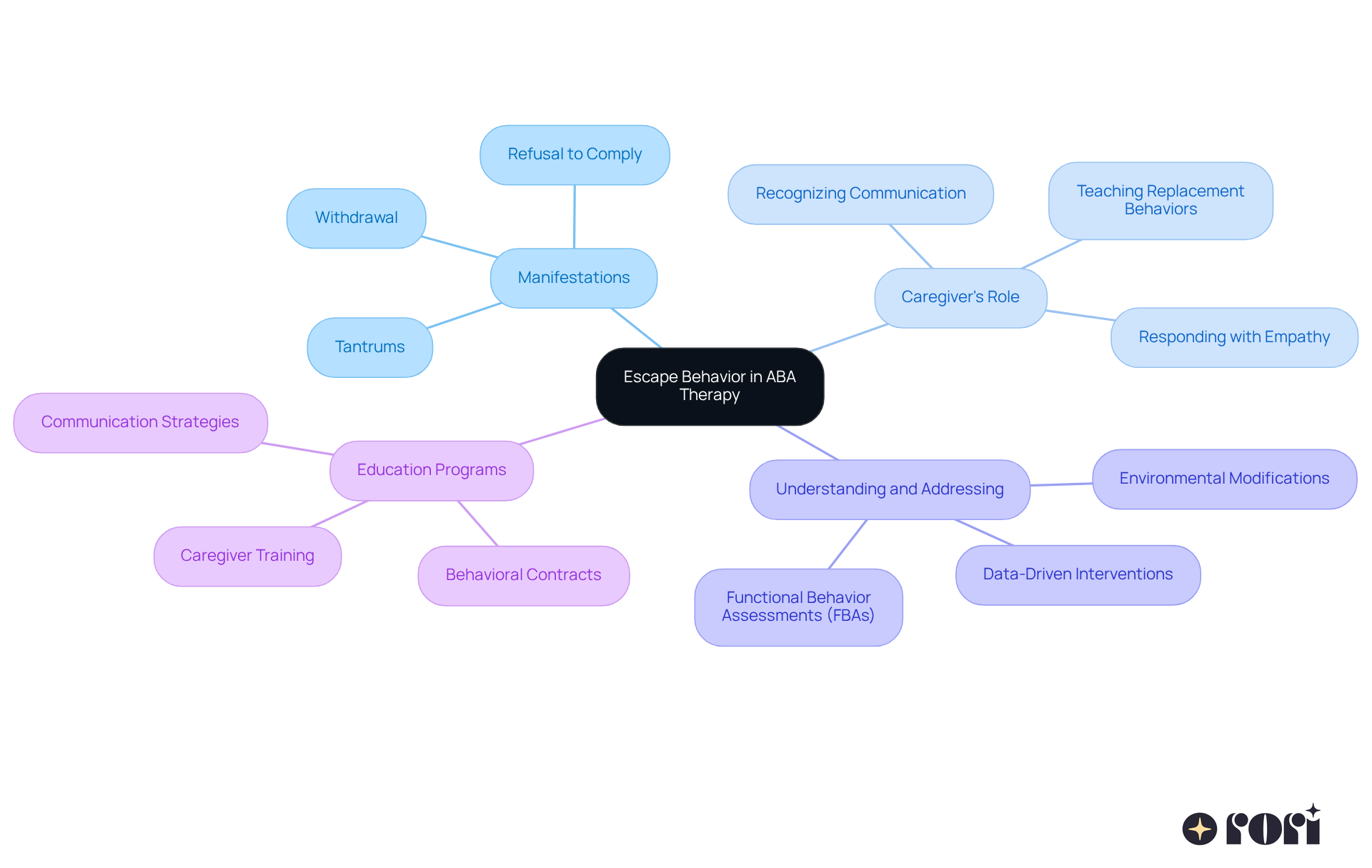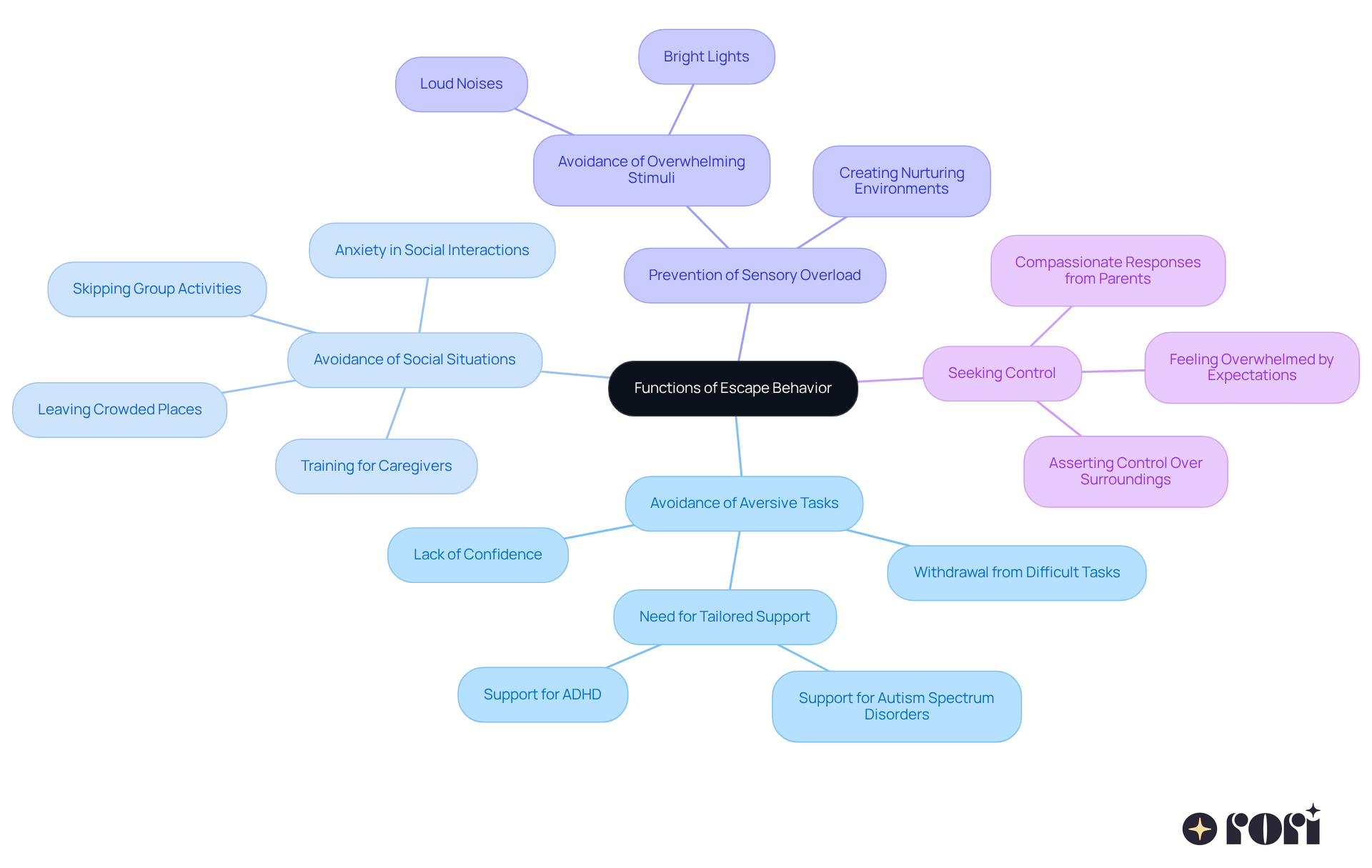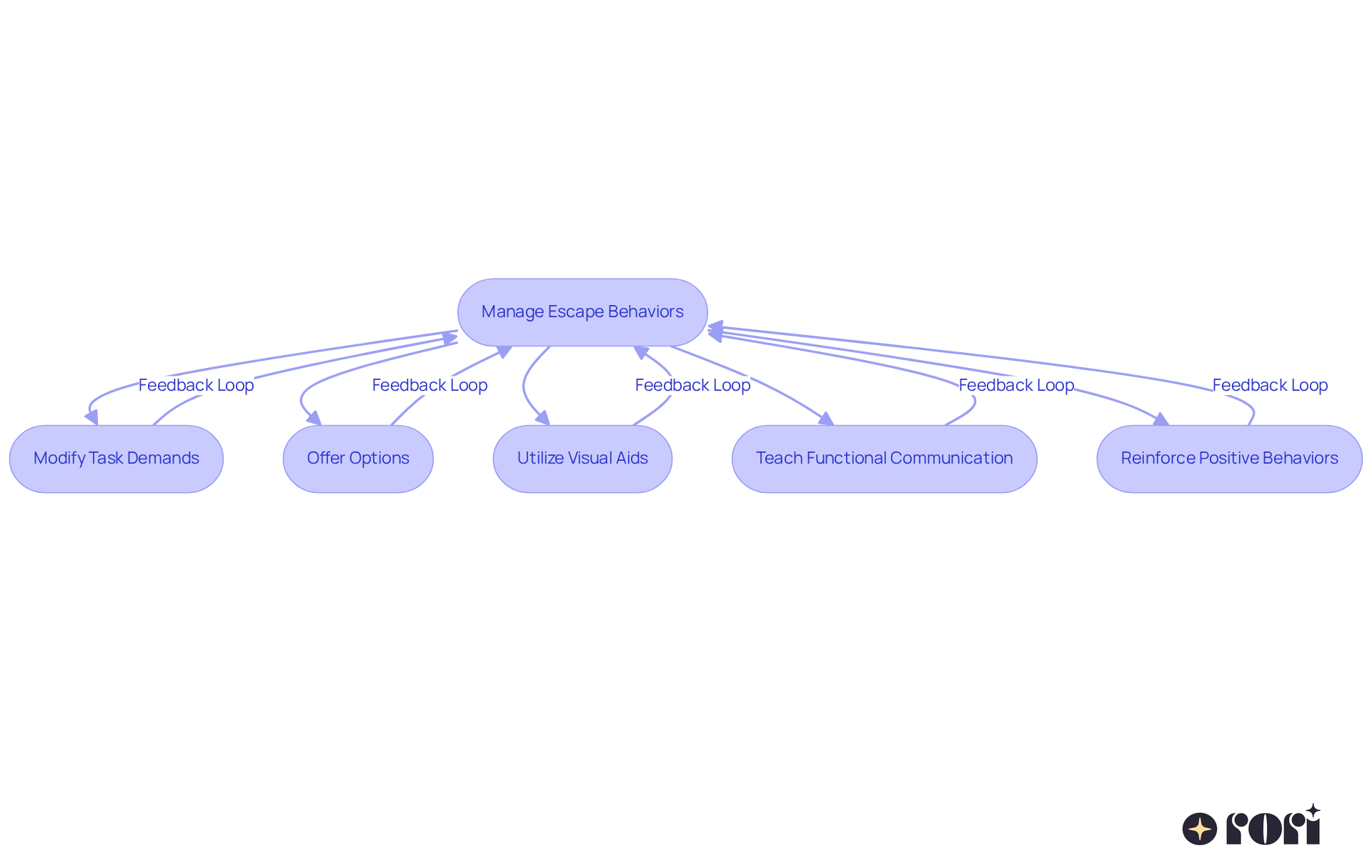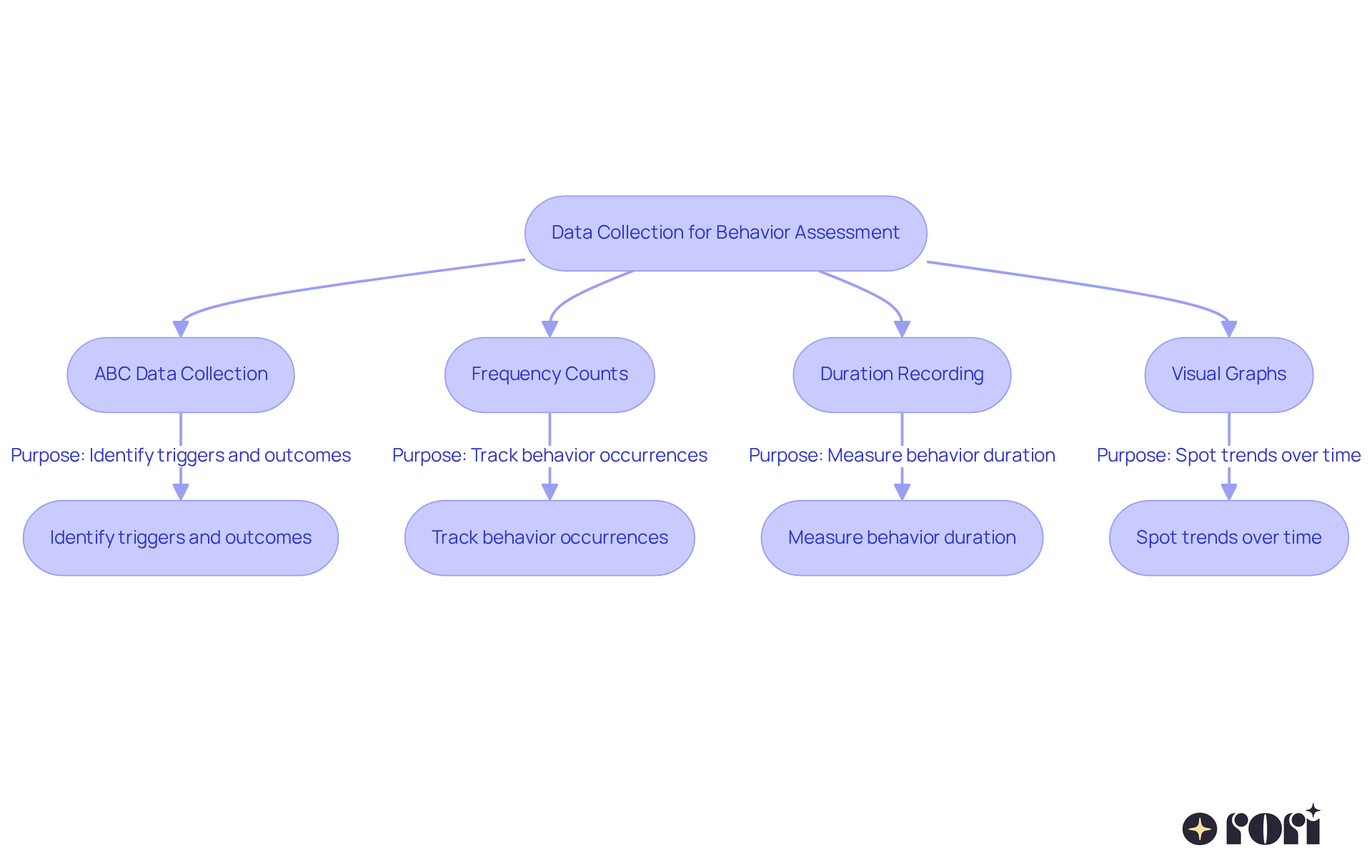This article dives into some helpful strategies that parents can use to support children who show escape behaviors, all within the framework of Applied Behavior Analysis (ABA) therapy. It's really important to understand why these behaviors occur—like avoiding tasks they find unpleasant or dealing with sensory overload. We’ll explore practical tips, such as:
to create a nurturing environment that encourages engagement and helps reduce those avoidance behaviors.
Let’s explore this together! By modifying how we present tasks and providing options, we can make a big difference in how our kids respond. Visual aids can be a fantastic way to clarify expectations and keep them engaged. Remember, you’re not alone in this journey; many parents face similar challenges, and it’s okay to seek help and resources.
We’re here to help you every step of the way! By understanding these behaviors and implementing supportive strategies, you can foster a more positive experience for your child. So, let’s take this journey together and create a supportive environment that truly makes a difference!
Understanding the complexities of escape behavior in children, especially those with Autism Spectrum Disorder (ASD), is so important for effective parenting and intervention. Escape behaviors, like tantrums or withdrawal, often signal a child’s struggle with challenging tasks or overwhelming environments. They serve as a form of communication, highlighting a child’s need for support.
This article is here to offer valuable strategies for parents to recognize and manage these behaviors. It also aims to foster a nurturing environment that promotes your child’s engagement and emotional well-being. How can we transform these challenging moments into opportunities for growth and connection? Let’s explore this together!
Escape actions are what young individuals do to dodge or wrap up unpleasant tasks or situations. In the world of Applied Behavior Analysis (ABA) therapy, actions like throwing tantrums, refusing to comply, or physically withdrawing from a task can be understood as escape behavior aba. Recent research reveals that those with Autism Spectrum Disorder (ASD) often display higher frequencies and stronger intensity of avoidance actions, mainly due to challenges in handling complex situations.
For instance, imagine a child throwing a tantrum just to avoid a tough homework assignment. This behavior signals their discomfort with the task, almost like a little message saying, 'I need help!' It’s crucial for caregivers to recognize this as a form of communication and respond with empathy. Understanding avoidance actions as reactions to perceived unpleasant stimuli is key. It helps caregivers focus on addressing the root issues rather than just reacting to the behaviors themselves.
By fostering an environment that encourages open communication and effective coping strategies, caregivers can significantly reduce the frequency of these avoidance actions and boost their child's engagement in learning activities. It’s also essential for caregivers to gain a deeper understanding of ABA principles and strategies to effectively tackle escape behavior aba. Participating in caregiver education programs can enhance support at home, complementing professional interventions and creating consistency.
This active involvement not only leads to better behavioral outcomes but also empowers caregivers, reducing stress and improving overall family dynamics. Let’s explore this together! We’re here to help you every step of the way!

Escape behavior aba in children often serves specific purposes, primarily aimed at avoiding or escaping unpleasant situations. Understanding these functions can really empower parents to develop effective intervention strategies. Let’s dive into the main functions:
Avoidance of Aversive Tasks: Kids might withdraw to dodge tasks they see as tough or undesirable, like homework or chores. This avoidance often comes from a lack of confidence or the skills needed to tackle the task. Tailored support is essential, especially for youth with Autism Spectrum Disorders and ADHD, who may face extra challenges with these tasks.
Avoidance of Social Situations: Some children show avoidance in social settings, like skipping group activities or leaving crowded places. This behavior, often referred to as escape behavior aba, can stem from anxiety or discomfort in social interactions. Training for caregivers can enhance understanding of these actions, helping parents make informed choices that positively influence their children's social growth.
Prevention of Sensory Overload: For kids with sensory sensitivities, escape behavior aba can involve avoidance actions to escape overwhelming stimuli, such as loud noises or bright lights, which can lead to distress. By equipping caregivers with knowledge about sensory processing, they can create nurturing environments that reduce triggers for avoidance actions.
Seeking Control: In certain situations, children may engage in avoidance actions to assert control over their surroundings, especially when feeling overwhelmed by external expectations. Recognizing this need for control allows parents to understand and respond to their children’s actions with compassion, particularly when addressing escape behavior aba.
Identifying these functions is crucial. It enables parents to approach their children's actions with empathy rather than frustration. By focusing on the underlying causes of these behaviors, parents can implement strategies that not only address the behavior but also support their children's emotional and developmental needs. Active involvement and alignment with therapeutic strategies often lead to more effective and lasting behavioral improvements, enhancing family dynamics in the process.
In summary, understanding avoidance actions and their purposes can significantly boost the effectiveness of interventions and support for children facing these challenges. We’re here to help you every step of the way!

Managing escape behavior aba can feel challenging, but there are some friendly strategies you can use that align with Applied Behavior Analysis (ABA) principles to enhance your caregiving skills. Let’s explore this together!
By incorporating these friendly tactics, you can create a nurturing atmosphere that reduces the need for escape behavior aba, ultimately enhancing your child's educational experience. Plus, integrating visual supports into daily routines can significantly improve engagement and lower anxiety levels. With a little education on ABA principles, you’ll feel empowered to make informed decisions that lead to better behavioral outcomes and provide enhanced support for your child. We’re here to help you every step of the way!

Understanding escape behavior aba can be quite the journey for parents, and utilizing effective data collection methods is essential in this process. At Rori Care - ABA Therapy, we focus on automatic data collection during clinical sessions. This means our clinical team is always there for your child, without interruptions for gathering data or writing report notes. Plus, all the information we gather is safely kept, anonymized, and removed after examination, giving you peace of mind.
Parents, here are some helpful techniques you can try:
ABC Data Collection: This method involves documenting the Antecedent (what happens before the action), Action (the avoidance behavior), and Consequence (what occurs after). By identifying triggers and outcomes linked to avoidance actions, you can create focused strategies. This data acts as a shared language among therapists, guardians, and caregivers, fostering teamwork in developing effective approaches.
Frequency Counts: Keeping track of how often avoidance actions occur within a specific timeframe can help you evaluate the effectiveness of interventions. Research shows that consistent frequency recording can greatly enhance your understanding of patterns and the success of interventions. Data collection is key for assessing and improving therapy outcomes in ABA therapy.
Duration Recording: Measuring how long escape actions last gives you insights into their severity and impact on daily activities. Duration information is crucial for understanding the extent of these actions and can guide necessary adjustments in strategies.
Visual Graphs: Creating visual representations of the data you collect can help you spot trends over time. Scatterplots can be especially handy for identifying patterns in occurrence trends. This method not only helps in assessing the effectiveness of strategies but also empowers you to make informed changes based on clear evidence.
By systematically gathering and analyzing data, you can gain a clearer understanding of your child's escape behavior aba and the effectiveness of the strategies you implement. This data-driven approach encourages collaboration between parents and therapists, ultimately leading to improved outcomes in escape behavior aba therapy. Let’s explore this together and see how we can support your child's journey!

Understanding and addressing escape behavior in children is so important for fostering their growth and development! This article highlights that escape behaviors, often seen as avoidance tactics in response to unpleasant tasks or situations, are actually important signals for caregivers. By recognizing these actions as forms of communication, parents can respond with empathy and implement supportive strategies that truly enhance their children's engagement and learning experiences.
Let’s dive into some key insights! Escape behavior can serve various functions, like avoiding aversive tasks, social situations, sensory overload, or even the need for control. By identifying these underlying causes, parents can adopt tailored strategies to manage these behaviors effectively. Techniques such as modifying task demands, offering choices, using visual aids, and reinforcing positive behaviors not only help reduce the frequency of escape actions but also create a nurturing environment that’s conducive to learning.
Ultimately, managing escape behaviors is a journey of collaboration and understanding. By actively engaging in data collection and utilizing effective assessment methods, parents can gain valuable insights into their children's behaviors, leading to improved therapeutic outcomes. Embracing these strategies not only empowers caregivers but also enhances family dynamics, ensuring that children receive the support they need to thrive.
So, let’s explore this together! Remember, you’re not alone on this journey, and we’re here to help you every step of the way!
What is escape behavior in the context of ABA therapy?
Escape behavior refers to actions taken by individuals, particularly children, to avoid or end unpleasant tasks or situations. In ABA therapy, this can include behaviors such as throwing tantrums, refusing to comply, or physically withdrawing from a task.
Why do individuals with Autism Spectrum Disorder (ASD) often exhibit escape behaviors?
Individuals with ASD may display higher frequencies and stronger intensities of escape behaviors due to challenges in handling complex situations, which can lead to discomfort and a desire to avoid certain tasks.
How can caregivers interpret a child's escape behavior?
Caregivers should view escape behaviors as a form of communication, indicating that the child may need help or is struggling with a specific task. Recognizing this can help caregivers respond with empathy and understanding.
What strategies can caregivers use to address escape behaviors?
Caregivers can reduce escape behaviors by fostering an environment that encourages open communication and effective coping strategies. This involves addressing the root issues rather than just reacting to the behaviors.
How can caregiver education programs help in managing escape behavior?
Participating in caregiver education programs can enhance caregivers' understanding of ABA principles and strategies, enabling them to effectively tackle escape behaviors and provide consistent support at home.
What are the benefits of caregivers being actively involved in managing escape behavior?
Active involvement leads to better behavioral outcomes for the child, empowers caregivers, reduces stress, and improves overall family dynamics.